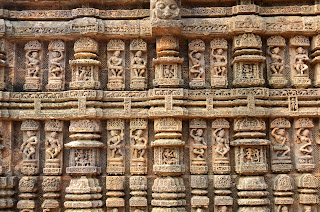This mornings drive took us through more wetlands along the coast.
First stop today was the Sun Temple of Konark. This was built around the 12th century and is now in ruins. It is considered a “dead” temple because at one point serves were stopped here. Once serves stop they can no longer be restarted.
First stop today was the Sun Temple of Konark. This was built around the 12th century and is now in ruins. It is considered a “dead” temple because at one point serves were stopped here. Once serves stop they can no longer be restarted.
The entrance way to the gate of the temple complex was fairly long and filled with vendors and lots of people.
The complex is surrounded by a wall and contains 3 buildings or chambers. One was for sacred dancing. This one is in pretty good shape but the roof is gone.
The complex is surrounded by a wall and contains 3 buildings or chambers. One was for sacred dancing. This one is in pretty good shape but the roof is gone.
The second building is the best preserved of all of the buildings. During the British occupation the British noted that it was in danger of collapsing so the filled the inner chamber with rubble from the larger building that had collapsed. This middle building is in the process of undergoing and full reconstruction.
The much of the upper portion of the last building had been destroyed but the lower levels seemed to have survived pretty well preserved. The restoration of this building has started but it will be a long time before it is fully restored.
The entire complex of three buildings were designed to look like a chariot with horses in front...
and had large “wheels carved into the sides. The spoke of the wheel acted as a sun dial with the spokes and other items on the wheel acting as hour markers.
and had large “wheels carved into the sides. The spoke of the wheel acted as a sun dial with the spokes and other items on the wheel acting as hour markers.
The facades of all of the buildings were heavily carved.
And the side gates and other areas had large figures standing guard.
The buildings are all made of sandstone that erodes easily. However, the buildings also have downspouts the water runoff. For the downspouts they used iron stone, a very hard stone, that won't erode from the water. And those were also very ornate.
for An interesting note: the term “Juggernaut” derives from Jagganath. During the annual Jaggannath Rath Yar_ (festival) the huge crowds would pull symbolic chariots through the streets. Sometimes the crowds were so large that they were basically unstoppable. This was observed during the British rule in India and they coined the word juggernaut to describe an unstoppable force (or at least that is what the guide told us).
And the side gates and other areas had large figures standing guard.
The buildings are all made of sandstone that erodes easily. However, the buildings also have downspouts the water runoff. For the downspouts they used iron stone, a very hard stone, that won't erode from the water. And those were also very ornate.
for An interesting note: the term “Juggernaut” derives from Jagganath. During the annual Jaggannath Rath Yar_ (festival) the huge crowds would pull symbolic chariots through the streets. Sometimes the crowds were so large that they were basically unstoppable. This was observed during the British rule in India and they coined the word juggernaut to describe an unstoppable force (or at least that is what the guide told us).
We had a short stop at the nearby museum that had a lot of artifacts from the temple.
After lunch it was off to another temple, the Jagannath Temple of Puri, one of the four major Dhamas (of India. A Dhamas is holy place or seat. There are four major Dhamas in India (in the north, south, east and western parts of India). It is very sacred to Hindus. This one is a living temple so non-Hindus were not allowed inside the temple gates. The mass of humanity as we approached the temple through the narrow streets was pretty intimidating with the packed crowds.
Once we were in the plaza things opened up. The admissions line was very long. We could see the crowds through the temple gate and the stairs looked packed.
We walked partway around the temple...Once we were in the plaza things opened up. The admissions line was very long. We could see the crowds through the temple gate and the stairs looked packed.
where we saw lots of vendors.
Many of the vendors were selling small pastries to be used as offerings.
There were lots of cows...
and monkeys....
and great people watching.
Mary got stopped by a group who wanted their picture taken with her.
Around 4:00pm a man started climbing the extremely steep side of the temple all the way to the top. He carried a number of flags with him and his job was to climb all the way to the very top and take down the old flags and put up new ones. This job is passed down through the generations.
Our hotel tonight is in Puri and it has a lovely pool.
Plus we are right on the beach. .We took a walk on the beach to enjoy the views and the activities.
Our hotel tonight is in Puri and it has a lovely pool.
Plus we are right on the beach. .We took a walk on the beach to enjoy the views and the activities.













































No comments:
Post a Comment